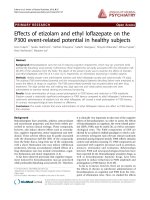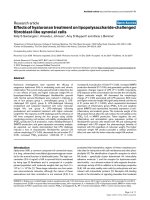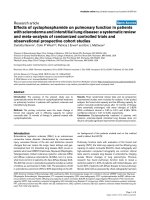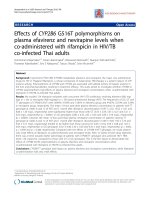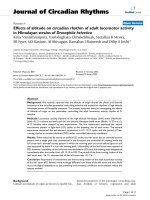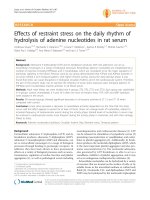Báo cáo y học: "Effects of evening light conditions on salivary melatonin of Japanese junior high school students" ppsx
Bạn đang xem bản rút gọn của tài liệu. Xem và tải ngay bản đầy đủ của tài liệu tại đây (219.58 KB, 5 trang )
BioMed Central
Page 1 of 5
(page number not for citation purposes)
Journal of Circadian Rhythms
Open Access
Research
Effects of evening light conditions on salivary melatonin of Japanese
junior high school students
Tetsuo Harada*
Address: Laboratory of Environmental Physiology, Faculty of Education, Kochi University, Kochi 780-8520, Japan
Email: Tetsuo Harada* -
* Corresponding author
Abstract
Background: In a previous study, when adult subjects were exposed to a level of 400 lux light for
more than 30 min or a level of 300 lux light for more than 2 hours, salivary melatonin concentration
during the night dropped lower than when the subjects were exposed to dim illumination. It was
suggested that such light exposure in adolescents or children during the first half of subjective night
in normal life might decrease the melatonin level and prevent the falling into sleep. However, there
has been no actual study on the effects of light exposure in adolescents.
Methods: Effects of exposure to the bright light (2000 lux) from fluorescent light bulbs during a
period of three hours from 19:30 to 22:30 in one evening were examined on evening salivary
melatonin concentrations from 19:45 to 23:40. The control group was exposed to dim light (60
lux) during these three hours. Both the dim light control group [DLCG] and the bright light
experimental group [BLEG] consisted of two female and three male adolescent participants aged
14–15 y.
Results: The salivary melatonin level increased rapidly from 3.00 pg/ml at 21:45 to 9.18 pg/ml at
23:40 in DLCG, whereas it remained at less than 1.3 pg/ml for the three hours in BLEG. Melatonin
concentration by BLEG at 22:30 of the experimental day was lower than that at the same time on
the day before the experimental day, whereas it was significantly higher in the experimental day
than on the day before the experimental day in DLCG.
Conclusions: Bright lights of 2000 lux and even moderate lights of 200–300 lux from fluorescent
light bulbs can inhibit nocturnal melatonin concentration in adolescents. Ancient Japanese lighting
from a traditional Japanese hearth, oil lamp or candle (20–30 lux) could be healthier for children
and adolescents because rapid and clear increase in melatonin concentration in blood seems to
occur at night under such dim light, thus facilitating a smooth falling into night sleep.
Background
Night sleep duration of Japanese children aged 10–18 y
has become shorter by one hour during the last 30 years
in Japan [1]. The so called "24-hour society", which is cur-
rently in progress in Japan, seems to change environmen-
tal conditions surrounding children. For example, mobile
phones are used by more than 90 % of university students
and more than 30% of junior high school students living
in the urban area of Kochi city (33°N) [2]. Students can
communicate with their colleagues even in the middle of
Published: 11 August 2004
Journal of Circadian Rhythms 2004, 2:4 doi:10.1186/1740-3391-2-4
Received: 02 April 2004
Accepted: 11 August 2004
This article is available from: />© 2004 Harada; licensee BioMed Central Ltd.
This is an open-access article distributed under the terms of the Creative Commons Attribution License ( />),
which permits unrestricted use, distribution, and reproduction in any medium, provided the original work is properly cited.
Journal of Circadian Rhythms 2004, 2:4 />Page 2 of 5
(page number not for citation purposes)
the night with mobile phones. Frequent or long-time
(more than 30 min) usage of the mobile phone makes
university and junior high school students more evening-
typed [2].
"Convenience stores" are open for 24 hours and provide
several kinds of food and other goods for general civilian
life. Convenience stores are now common all over Japan
even in suburban areas. Illumination inside the conven-
ience stores is very bright (2000 lux or more at the level of
the eyes). Bright lighting in retail stores seems to be a mer-
chandising technique which has been in use worldwide
for at least 60 years. Unconscious use of bright light in the
evening or at night inside the convenience store may pro-
mote a circadian phase delay in students exposed to the
bright light during the first half of subjective night. This
hypothesis is based on a "light-pulse" experiment in the
laboratory [3] as follows. Adult subjects were exposed to
light pulse of 4000–6000 lux for 30 min at one of several
phase points of their circadian rhythm, and the direction
(advance or delay) and the extent of phase shift caused by
the pulse were measured at each phase point. The light
pulse delayed the phase of sleep-wake cycle by the sub-
jects when they were exposed to the light pulse in the first
half (about 19:00–24:00) of subjective night. However, it
advanced the phase effectively when the subjects were
exposed to it within three or four hours after the mini-
mum point of inner body temperature (about 5:00–9:00).
An epidemiological study about the effect of the conven-
ience store usage was conducted on sleep habits and diur-
nal rhythm by about 500 students attending junior high
school aged 12–15 y in Kochi Japan [4]. This latter paper
reported the following three points: (1) Students going to
convenience stores after sunset were more evening-typed
and showed shorter night sleep of 7.0 hours on average
than those going to convenience stores during the day-
time, who showed night sleep of 7.3 hours on average, (2)
Students who went to convenience stores every day slept
only 6.4 hours on average and the sleep hours were signif-
icantly shorter than the 7.5 hours shown by students who
went to convenience stores only 0–1 time per week, (3)
Students who stayed more than 30 min in convenience
stores took shorter night sleep of 6.6 hours on average
than those who stayed there less than 15 min. (7.3 sleep
hours). Younger children attending kinder garden and
students attending elementary school were more sensitive
to "light conditions" in normal life than university stu-
dents, according to an epidemiological study [5]. How-
ever, no experimental field studies on the effects of "light
conditions" during normal life have been conducted on
sleep-wake cycles of healthy children younger than 15 y.
Melatonin, which is synthesized in the pineal organ and
secreted to the blood, is well known as a key substance
which may be effective in promoting the falling into night
sleep by humans [6]. Blood melatonin concentration by
adult human subjects is extremely low during daytime
and increases rapidly at 22:00–23:00 up to as much as ten
or twenty times daytime values. The high level is main-
tained till the early morning and then decreases again rap-
idly to the extremely low concentration typical of the
daytime [7,8]. The increase in melatonin concentration
might occur in late evening and trigger the falling into
sleep also for healthy children, although there have been
no studies on melatonin concentration in salivary or
blood under their normal life. In adult subjects, a single
administration of 5 mg of melatonin at 13:00 was
reported to induce higher subjective sleepiness during the
following 2 hours and also higher EEG power density in
the range of relatively low frequency of 5.25–9.0 Hz rather
than that of placebo [9]. When adult subjects were
exposed to 400 lux lights for more than 30 min or exposed
to 300 lux lights for more than 2 hours, melatonin level
during the night became lower than that when they stayed
under dimmer lights [10,11]. In the case of adolescents
and children, the exposure to lights of 300 lux or more
during the first half of subjective night in the normal life
might decrease their melatonin level and prevent the fall-
ing into sleep.
Currently, more than 80% of junior high school students
of the third grade aged 14–15 y in Kochi go to private
school in the evening. If they take a short stop at the con-
venience store to get some fast food and enjoy talking
with their colleagues in front of the store before or after
going to the private school in the evening, they suffer the
double exposure to bright lights at the school and at the
convenience store. Such bright lights are from fluorescent
light bulbs and include blue or blue-green lights with
470–500 nm wave lengths which were reported to be
powerful to suppress melatonin concentration [12]. Based
on the epidemiological studies made in 2001–2003 on
junior high school students in Kochi Prefecture (33°N),
38.8% of the students who frequented convenience stores
went there after sunset, and 30.2% and 6.5% of junior
high school students who used convenience stores went
there and stayed there for 15–30 min and longer than 30
min, respectively. Moreover, this epidemiological study
showed that 62.4% and 18% of the students who went to
the evening private school studied there for 2 and 3 hours
until 9 or 10 o'clock in the evening, respectively. In total,
junior high school students were estimated to be exposed
to bright lights of more than 2000 lux inside private
school and/or convenience store for 2–3.5 hours on aver-
age in the evening. Such exposures are expected to sup-
press the increase in blood melatonin level as a direct
effect and also delay the phase of their circadian systems
driving melatonin secretion rhythm and sleep-wake cycle.
Journal of Circadian Rhythms 2004, 2:4 />Page 3 of 5
(page number not for citation purposes)
In this study, two light conditions were investigated. One
was bright and high color-temperature light of more than
2000 lux, which is used in the evening and at night inside
the convenience stores, at preliminary and private school
for entrance examination, and at rental video shops in
Japan. The other condition was a dark and low color-tem-
perature light with less than 60 lux which is usual in the
evening for traditional Japanese settings (a fireplace, can-
dle, or a naked light bulb).
Methods
Participants
Experimental participants were ten Japanese junior high
school adolescent students (4 females and 6 males) aged
14–15 y who were attending Motoyama junior high
school located in the mountain area of Reihoku district
(33.5°N) in Kochi Prefecture. They had enjoyed New Year
holidays for 7 days before the experiment. They were
instructed to keep usual diurnal rhythm (for example bed
time and wake-up time) during the holidays. Before the
experiment, participants were divided into the two groups
of "bright light experimental group (BLEG)" and "dim
light control group (DLCG)". Participants in BLEG were
selected to show similar circadian typology to those in
DLCG based on the scores in the morningness-evening-
ness (M-E) questionnaire of Torsvall and Åkerstedt [13]
(mean ± SD: 15.00 ± 4.30 by BLEG and 14.80 ± 4.09 by
DLCG). Bed time, wake-up time and sleep hours shown
by BLEG for the four days just before the experiment were
23.0 ± 4.2 hours, 8.4 ± 1.9 hours and 9.1 ± 1.4 hours,
respectively; corresponding values for DLCG were 23.8 ±
1.3 hours, 8.9 ± 1.3 hours, and 9.5 ± 1.5 hours. Each
group consisted of two females and three males. All the
ten participants sampled their own saliva using "Salivette"
collecting tubes (SARSTEDT Aktiengesellschaft & Co.,
Numbrecht, Germany) at 22:30–23:00 under the 200–
300 lux light from fluorescent light bulbs in their home
on the day before the experimental day.
Japanese civilians seem to enjoy evening time during the
first half of subjective night (after sunset till bedtime)
under fluorescent light bulbs based on our unpublished
questionnaire study on 950 families having small chil-
dren aged 0–6 yrs in Kochi. More than 85% of the 950
families enjoyed evening life under fluorescent light
bulbs. We measured the illumination at the level of 1 m
above floor just under a usual type of round-shaped fluo-
rescent light bulb in a typical one-room apartment for stu-
dents and it was 340 lux.
Procedure
On the experimental day of the 5
th
January 2003, all the
ten participants got together in front of Motoyama junior
high school at 8:00 in the morning. A wagon car took
them to the experimental place which was a Japanese style
hotel located at a mountain area, Yusuhara town in Kochi
Prefecture, 126 km west from Motoyama town. During
the driving, illumination inside the car was 350–500 lux.
The car arrived at the hotel around noon. It was snowing
through the day. Behavior of all the participants was con-
trolled during the stay in the hotel till the next morning of
the experimental day. All the participants played outside
exposed to the sun light with 6000–7500 lux at the eye
level during 12:30–13:30 and 14:00–14:50. They were
allowed to have a rest in a living room in which the floor
was filled with 12 tatami mats and the illumination at the
eye level was 250 lux from fluorescent light bulbs during
the rest of the time till 16:30. Participants took bath one
by one between 16:30–18:00 and had supper all together
between 18:15 and 19:20 in the living room. At 19:25, the
participants of BLEG moved to a Japanese style room with
8 tatami mats where they were exposed to the light with
2000 lux at the eye level from fluorescent light bulbs,
whereas DLCG group members moved to another Japa-
nese style room with 8 tatami mats where they were
exposed to the light of 60 lux and relatively low color-tem-
perature from a electronic light bulb. All the participants
included in both groups were home-working or making a
small wooden folk craft object that is typical in the Yusu-
hara district, under each light condition till 22:30. Room
temperature was controlled at 15 ± 2°C with an oil heater
in both groups. Then they came back to the former living
room (12 tatami mats) and stayed there under the light of
250 lux till 23:40. Then female and male participants
moved to separate rooms and went to bed just before
24:00. Salivary samples were collected in collection tubes
at 21:45, 22:30, and 23:40, and these salivary samplings
were preserved in a refrigerator at less than -20°C. Mela-
tonin concentration in the samples was analyzed by a pro-
fessional analyzing company (MSL Co. Ltd.) which was a
specialist for several chemical and microbiological analy-
ses. All the participants from both groups were called out
to get up at 7:00 in the next morning. All the participants
got up between 7:00–7:15 responding to the calling out.
After taking breakfast, they left the experimental place at
9:00 back for Motoyama junior high school. Throughout
the study, light exposure was measured on the eye level
with a digital illumination meter.
Detailed explanation of the objectives and methods of the
experiment was provided before the experimental per-
formance to the participants and their parents. The
research project received full and complete agreement
from all of them.
Results and Discussion
The results are shown in Fig. 1. Salivary melatonin con-
centration rose from 3.00 ± 3.34 (mean ± SD) pg/ml at
21:45 to 9.18 ± 7.66 pg/ml at 23:30 of the experimental
day in the DLCG (t-test between values at 21:45 and
Journal of Circadian Rhythms 2004, 2:4 />Page 4 of 5
(page number not for citation purposes)
23:30: t = 3.60, df = 4, p < 0.05), whereas it remained at
less than 1.3 pg/ml till 23:30 in BLEG (t = 2.07, df = 4, p
< 0.2). There was no significant difference in the mela-
tonin concentration between BLEG and DLCG in the day
before the experimental day (Wilcoxon test: z = -1.163, p
= 0.31). At 22:30 of the experimental day, melatonin con-
centration by BLEG tended to be lower than that on the
day before the experimental day (Wilcoxon test: z = -
1.604, p = 0.109), while the concentration became signif-
icantly higher in DLCG (z = -2.023, p = 0.043). On the day
before the experimental day, all the participants were
under Japanese standardized light condition with 200–
400 lux from a fluorescent light bulb with relatively high
color-temperature. On the experimental day, the bright
light of 2000 lux in BLEG suppressed the expected night
increase of melatonin concentration, whereas the rela-
tively low color- temperature light with 60 lux did not.
In Japan, bright and high color-temperature light of more
than 2000 lux is available in the evening or night inside
convenience stores which are open for 24 hours and pri-
vate schools for the preparation to go through the
entrance examination to upper schools. Also in usual life,
such exposures to bright lights in the evening private
school and convenience store can suppress the night
increase in blood melatonin level as a direct effect and
possibly delay the circadian system that drives the mela-
tonin secretion rhythm and sleep-wake cycle.
Effects of light condition on salivary melatonin concentrationFigure 1
Effects of light condition on salivary melatonin concentration. Values shown are means (n = 5 per group) and SEM.
Publish with BioMed Central and every
scientist can read your work free of charge
"BioMed Central will be the most significant development for
disseminating the results of biomedical research in our lifetime."
Sir Paul Nurse, Cancer Research UK
Your research papers will be:
available free of charge to the entire biomedical community
peer reviewed and published immediately upon acceptance
cited in PubMed and archived on PubMed Central
yours — you keep the copyright
Submit your manuscript here:
/>BioMedcentral
Journal of Circadian Rhythms 2004, 2:4 />Page 5 of 5
(page number not for citation purposes)
The results of this study suggest that ancient Japanese
lighting in the evening and at night, which could be
supplied by a traditional Japanese hearth fire or a oil lamp
or candle (20–30 lux), might be healthy for adolescents
and children, because the ancient lights could allow rapid
and clear increase in melatonin level leading to a smooth
falling into night sleep [14].
Conclusions
Bright lights of 2000 lux and even moderate lights of 200–
300 lux can inhibit, as a direct effect, nocturnal melatonin
concentration in children. Ancient Japanese light condi-
tions which could be supplied by a traditional Japanese
hearth fire or a small oil lamp or candle might be healthy
for children, because the ancient lights could allow rapid
and clear increase in melatonin level in the evening, lead-
ing to a smooth falling into night sleep.
Competing interests
None declared.
Acknowledgement
I would like to thank all 10 participants attending Motoyama junior high
school and their parents for well understanding of the objects of this study
and nice participation with complete agreements. Thanks are also due to
the staff of the Japanese style hotel which was used as the experimental
place, educational staffs in Reihoku District especially Mr. Hirotaka
Kageyama, Vice-principal of Motoyama junior high school and Mr. Yasuhiro
Yamashita, Principal of Ohsugi junior high school, and all the staffs of Japan
Broadcasting Corporation for invaluable helps to the preparation and per-
formance of the experiment. This study was supported by Support Funds
to Researches by President of Kochi University, 2003–2005, and Meiji-Yas-
uda Mental Health Foundation, 2004–2005 to T. Harada.
References
1. Fukuda K, Ishihara K: Research work on life habits and tiredness
in Japanese elementary, junior high and senior high school
students. Reports of Study Supported by Ministry of Sciences and Tech-
nologies for Science Promotion Japanese Ministry of Sciences and
Technologies; 2000.
2. Harada T, Morikuni M, Yoshii S, Yamashita Y, Takeuchi H: Usage of
mobile phone in the evening or at night makes Japanese stu-
dents evening-typed and night sleep uncomfortable. Sleep and
Hypnosis 2002, 4:150-154.
3. Honma K, Honma S: A human phase-response curve for bright
light pulses. Jap J Psychiat Neurol 1988, 42:167-168.
4. Harada T, Takeuchi H: Do evening usages of convenience store,
mobile phone and mid-night programs of TV induce the
sleep shortage of Japanese children? Japanese Journal of Clinical
Dentistry for Children 2003, 8:57-67. In Japanese
5. Harada T, Takeuchi H: Epidemiological study on diurnal rhythm
and sleep habits of Japanese students aged 9–22 y. Annals of
Japanese Society for Chronobiology 2001, 3:37-46. (In Japanese)
6. Zhdanova IV, Wurtman RJ, Lynch HJ, Ives JR, Dollina AB, Morabito C,
Matheson JK, Schomen DL: Pharmacodynamics and drug action;
Sleep-induced effects of low doses of melatonin ingested in
the evening. Clin Pharmacol Ther 1995, 57:552-558.
7. Hashimoto S, Nakamura K, Honma S, Tokura H, Honma K: Mela-
tonin rhythm is not shifted by lights that suppress nocturnal
melatonin in humans under entrainment. Am J Physiol 1996,
270:R1073-R1077.
8. Hashimoto S, Honma K: Biological Rhythms. In Researches on Sleep
Environments for Sleep Edited by: Torii S. Tokyo: Asakura Shoten;
1999:23-36. in Japanese
9. Cajochen C, Krauchi K, Wirz-Justice A: The acute soporific action
of daytime melatonin administration: effects on the EEG
during wakefulness and subjective alertness. J Biol Rhythms
1997, 12:636-643.
10. Aoki H, Yamada N, Ozeki Y, Yamane H, Kato N: Minimum light
intensity required to suppress nocturnal melatonin concen-
tration in human saliva. Neurosci Lett 1998, 252:91-94.
11. Kohsaka M, Oyama E, Hashimoto S, Hoseki S, Honma Y, Mishima K:
Lights and Health Edited by: Okawa M, Honma K. Osaka: Matsushita
Electric Co Ltd; 1999.
12. Wright HR, Lack LC: Effect of light wavelength on suppression
and phase delay of the melatonin rhythm. Chronobiol Int 2001,
18:801-808.
13. Torsvall MD, Åkerstedt T: A diurnal type scale: construction,
consistency and validation in shift work. Scand J Work Environ
Health 1980, 6:283-290.
14. Lewy AJ, Wehr TA, Goodwin FK, Newsome DA, Markey SP: Light
suppresses melatonin secretion in humans. Science 1980,
210:1267-1269.

